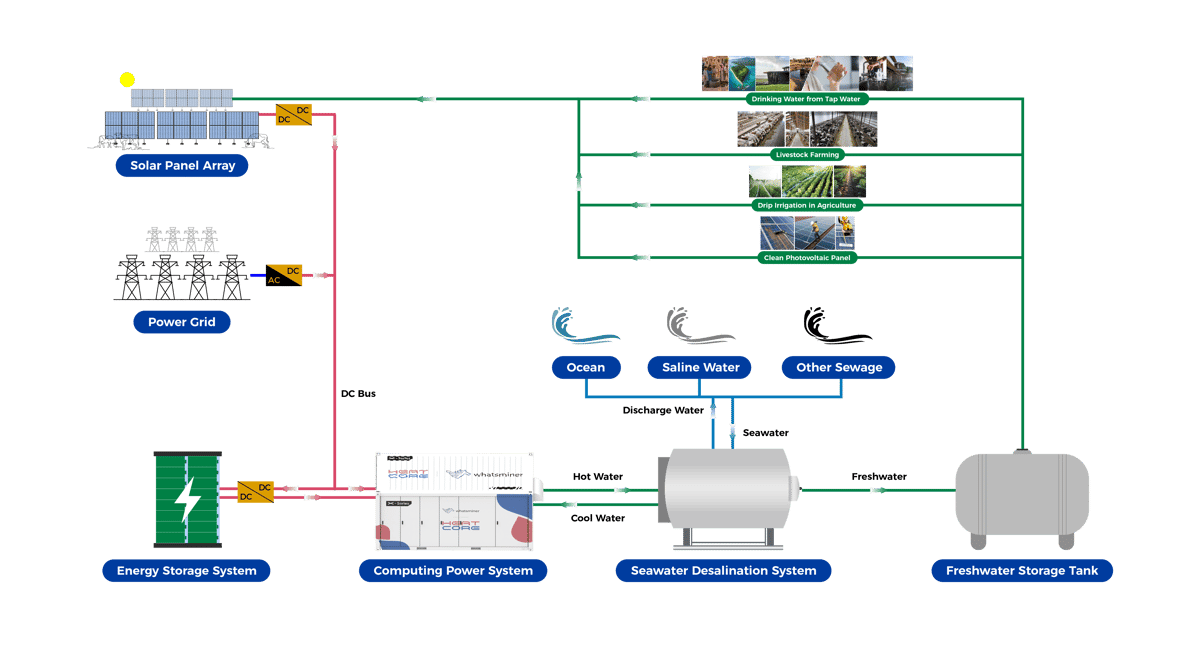SEAWATER DESALINATION SOLUTION
To reuse the heat from Hydro mining system and generate fresh water
----------------------------------------------------------------------------------------------------------------------------------
According to UN data, over 40% of the global population faces freshwater shortages, especially in arid regions such as the Middle East, North Africa, South Asia, and the western United States. The United Nations Environment Programme (UNEP) predicts that by 2050, global freshwater demand will increase by 50%, making water scarcity an even more pressing issue amid climate change, population growth, and urbanization.
To address these challenges, Heatcore introduces the “IDC Waste Heat + Distillation” solution—transforming mining heat into sustainable freshwater, building the foundation for a low-carbon water ecosystem.
Seawater Desalination Solution

Urban Water Networks Constraints
Urban water networks rely on long-distance pipelines, which are costly, prone to contamination, and have limited reach in remote areas. These challenges make it difficult to provide stable and safe freshwater supplies.

Off-Grid Water Challenges
Rural, desert, and island regions lack access to centralized water grids, relying on groundwater or long-distance transport, which is expensive, unsustainable, and increases environmental risks.

Challenges with Complex Water Sources
In arid regions and saline zones, communities often face highly saline groundwater, brackish water, or direct seawater. These water sources are difficult to treat, and unsuitable for drinking or irrigation without advanced purification.

OUR SOLUTION
To address these challenges, Heatcore introduces an efficient and sustainable Seawater Desalination Solution based on the “IDC Waste Heat + Distillation” approach. By harnessing waste heat from mining operations, the system produces clean freshwater while achieving complete energy independence through optional integration with renewable energy sources. Its modular design ensures scalability and adaptability across diverse environments, supporting sustainable water supply for agriculture, livestock farming, and off-grid communities, and laying the foundation for a low-carbon water ecosystem.
We generate fresh water by using the heat from Bitcoin mining
Waste heat from the mining process is transferred to the seawater desalination system, where it powers the distillation process to convert seawater water into freshwater. This system can desalinate not only seawater but also brackish water, industrial wastewater, and domestic sewage after pre-treatment
THE FRESHWATER IS THEN STORED AND DISTRIBUTED FOR
· Domestic Supply In Off-Grid Areas· Agricultural Irrigation To Support Crop Growth
· Livestock Farming To Ensure A Stable Water Source
SYSTEM SPECIFICATIONS
Dimensions & Weight. Flow Rates & Temperatures
| Hot Water |
Temperature Inlet/Outlet(℃) |
65-80/50-70 | ||
|
Flow(m3/h) |
96 |
|||
| Seawater |
Temperature Inlet/Outlet(℃) |
<36 |
||
|
Flow(m3/h) |
150 |
|||
|
Total Dissolved Solids |
<38000 |
|||
| Desalinated Water |
2 Units M53/M63/M65 Series | 48 | ||
| Total Dissolved Solids(ppm) | <10 | |||
| Dimensions and Weight(mm/T) |
Desalination Equipment |
1850×1850×1930mm/2.2T |
||
| Container |
6058×2438×2896mm/7.5T |
|||
Water Production Example: 1600kW System
A 1600kW System Can Generate 48 Tons Of Freshwater Per Day. The Produced Water Meets International Drinking Water Standards, Including CHINA / USA / WTO Regulations, As Confirmed By Water Quality Reports

Quantified Water Utilization
One 1600kW System Can Sustainably Support Diverse Usage Scenarios Across Agriculture, Hospitality, And Clean Energy Maintenance
According to UN data, over 40% of the global population faces freshwater shortages, particularly in arid regions such as the Middle East, North Africa, South Asia, and the western United States. The United Nations Environment Programme (UNEP) predicts that by 2050, global freshwater demand will increase by 50%, making water scarcity an even more pressing issue amid climate change, population growth, and urbanization.
Urban Water Networks Constraints
Urban water networks rely on long-distance pipelines, which are costly, prone to contamination, and have limited reach in remote areas. These challenges make it difficult to provide stable and safe freshwater supplies.
Off-Grid Water Challenges
Rural, desert, and island regions lack access to centralized water grids, relying on groundwater or long-distance transport, which is expensive, unsustainable, and increases environmental risks.
To address these challenges, Heatcore provides an efficient and sustainable Seawater Desalination Solution. This solution features a modular design for scalability and adaptability across diverse environments, complete energy independence by relying solely on renewable energy sources, and a sustainable water supply to support agriculture and livestock farming.
(插入海水淡化解决方案系统图-重点标注矿机系统和海淡机部分)
We generate fresh water by using the heat from Bitcoin mining
Waste heat from the mining process is transferred to the seawater desalination system, where it powers the distillation process to convert seawater water into freshwater. This system can desalinate not only seawater but also brackish water, industrial wastewater, and domestic sewage after pre-treatment.
The produced freshwater is stored in tanks and can be used for:
- Domestic supply in off-grid areas
- Agricultural irrigation to support crop growth
- Livestock farming to ensure a stable water source
System Specifications
1.Dimensions & Weight / 尺寸 & 重量
2.Flow Rates & Temperatures / 热水/海水/淡水端流量及温度
-插入技术规格表
Water Production Example: 1600kW System
A 1600kW system can generate 48 tons of freshwater per day. The produced water meets international drinking water standards, including CHINA / USA / WTO regulations, as confirmed by water quality reports.-插入水质报告图
Quantified Water Utilization
Agriculture & Livestock & Hospitality & Catering & Photovoltaic Panel Cleaning
Supports 19,600 sheep
Sustains coffee trees producing 21.8kg of coffee beans
Irrigates 17,778 date palm trees
Provides freshwater for 150-218 hotel rooms
Supports 480-960 diners' water consumption in restaurants
Supplies cleaning water for five 1600kW photovoltaic panel systems






